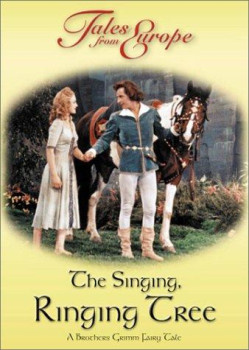The Singing Ringing Tree facts for kids
Quick facts for kids The Singing Ringing Tree |
|
|---|---|
 |
|
| Directed by | Francesco Stefani |
| Produced by | Alexander Delete |
| Written by | Anne Geelhaar Francesco Stefani |
| Starring | Richard Krüger Eckart Dux Christel Bodenstein |
| Music by | Heinz-Friedel Heddenhausen |
| Cinematography | Karl Plintzner |
| Editing by | Christa Wenicke |
| Distributed by | DEFA |
| Release date(s) | 13 December 1957 |
| Running time | 73 minutes |
| Country | East Germany |
| Language | German |
The Singing Ringing Tree (in German: Das singende, klingende Bäumchen) is a magical fantasy film made in 1957. It was created by the East German film studio DEFA. The movie was directed by Francesco Stefani. The story, written by Anne Geelhaar, is based on a fairy tale by the famous Brothers Grimm.
Contents
What is The Singing Ringing Tree About?
A Princess's Wish for a Magical Tree
The story begins with a very beautiful princess. However, she is also quite selfish and proud. A rich prince asks her to marry him. She turns him down and doesn't like his gifts. The princess tells him she will only marry him if he brings her the amazing "singing ringing tree."
The Prince's Deal with a Dwarf
The prince finds the special tree in the land of a mean dwarf. The dwarf offers to give him the tree. But there's a catch: if the princess still says no to him, the prince will become the dwarf's prisoner. He will then be turned into a bear.
The tree only sings and rings when the princess truly falls in love with the prince. Because she doesn't love him yet, the tree stays silent. The princess is disappointed and still rejects the prince. So, the prince has to go back to the dwarf's home and is turned into a bear.
The Princess's Transformation
The princess then sends her father, the king, to find the singing ringing tree for her. The king meets the prince, who is now a bear. The bear gives the king the tree. But he makes a deal: the king must return with the first thing he sees when he gets home.
That "first thing" turns out to be the princess! She is then taken to the dwarf. The dwarf sees how selfish the princess is. He casts a spell to make her look ugly. The bear tells her that her beauty will only come back if she changes her ways.
Slowly, the princess starts to like the bear and becomes kind. Her beauty returns. The dwarf tries to keep them apart. But in the end, the princess falls in love with the prince. When she does, the singing ringing tree finally starts to sing and ring!
Who Are the Main Characters?
- Christel Bodenstein plays the proud princess.
- Charles Hans Vogt plays the king, the princess's father.
- Eckart Dux plays the handsome prince, who turns into a bear.
- Richard Krüger plays the dwarf, who causes trouble.
- Dorothea Tiesing plays the nurse.
- Günther Polensen plays the captain of the guard.
- Fredy Barton plays the minister.
- Egon Vogel plays the captain and master of ceremonies.
- Paul Knopf plays the guardian.
- Paul Pfingst plays Bauer.
- Friedrich Teitge plays the gardener.
- Maria Besendahl (Anna-Maria Besendahl) plays the herbalist.
How Was the Film Made?
The movie was filmed entirely in a studio in Potsdam, which is in East Germany. There was some confusion about the actor who played the dwarf. People wondered if it was Richard Krüger or Hermann Emmrich. Now, it is believed they were the same person.
When Was the Film Released?
After its release in East Germany, the film was very popular. Over 5.9 million tickets were sold in a country of about 17 million people.
The BBC bought the film and split it into three parts. They made it into a mini-series called Tales from Europe. It was first shown on black and white TV from November 19, 1964, to December 3, 1964. The original German voices were heard, but an English voice-over was added. The series was shown many times until 1980.
In 1988, the film was released on VHS video in Germany. Now, you can find it on DVD and even watch it on Amazon Prime.
How Did People in the UK React to the Film?
The TV series was quite memorable for children in the UK. Many found it a bit scary because it was a foreign fairy tale and from Germany. It was described as "one of the most frightening things ever shown on children's television."
When the DVD came out in 2002, people became interested in it again. In 2004, a poll by Radio Times readers voted The Singing Ringing Tree the 20th spookiest TV show ever.

